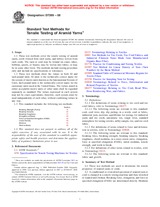Potrebujeme váš súhlas na využitie jednotlivých dát, aby sa vám okrem iného mohli ukazovať informácie týkajúce sa vašich záujmov. Súhlas udelíte kliknutím na tlačidlo „OK“.
ASTM D7269-08
Standard Test Methods for Tensile Testing of Aramid Yarns
Automaticky preložený názov:
Štandardné testovacie metódy pre skúšanie ťahom aramidového priadze
NORMA vydaná dňa 1.8.2008
Informácie o norme:
Označenie normy: ASTM D7269-08
Poznámka: NEPLATNÁ
Dátum vydania normy: 1.8.2008
Kód tovaru: NS-38042
Počet strán: 12
Približná hmotnosť: 36 g (0.08 libier)
Krajina: Americká technická norma
Kategória: Technické normy ASTM
Anotácia textu normy ASTM D7269-08 :
Keywords:
aramid, linear density, tensile properties/tests, tire cord, tire fabric, Aramid fibers, Linear density, Tensile properties/testing, Tire cords and tire cord fabrics, Yarns, ICS Number Code 59.080.20 (Yarns)
Doplňujúce informácie
| Significance and Use | ||||||||||||||||||
|
The levels of tensile properties obtained when testing aramid yarns and tire cords are dependent on the age and history of the specimen and on the specific conditions used during the test. Among these conditions are rate of stretching, type of clamps, gage length of specimen, temperature and humidity of the atmosphere, rate of airflow across the specimen, and temperature and moisture content of the specimen. Testing conditions accordingly are specified precisely to obtain reproducible test results on a specific sample. Because the force-bearing ability of a reinforced rubber product is related to the strength of the yarn or cord used as a reinforcing material, breaking strength is used in engineering calculations when designing various types of textile reinforced rubber products. When needed to compare intrinsic strength characteristics of yarns or cords of different sizes or different types of fiber, breaking tenacity is very useful because, for a given type of fiber, breaking force is approximately proportional to linear density. Elongation of yarn or cord is taken into consideration in the design and engineering of reinforced rubber products because of its effect on uniformity of the finished product and its dimensional stability during service. The FASE is used to monitor changes in characteristics of the textile material during the various stages involved in the processing and incorporation of yarn or cord into a rubber product. Modulus is a measure of the resistance of yarn or cord to extension as a force is applied. It is useful for estimating the response of a textile reinforced structure to the application of varying forces and rates of stretching. Although modulus may be determined at any specified force, initial modulus is the value most commonly used. Work-to-break is dependent on the relationship of force to elongation. It is a measure of the ability of a textile structure to absorb mechanical energy. Breaking toughness is work-to-break per unit mass. It should be emphasized that, although the preceding parameters are related to the performance of a textile-reinforced product, the actual configuration of the product is significant. Shape, size, and internal construction also can have appreciable effect on product performance. It is not possible, therefore, to evaluate the performance of a textile reinforced product in terms of the reinforcing material alone. If there are differences of practical significance between reported test results for two laboratories (or more), comparative tests should be performed to determine if there is a statistical bias between them, using competent statistical assistance. As a minimum, test samples should be used that are as homogeneous as possible, that are drawn from the material from which the disparate test results were obtained, and that are randomly assigned in equal numbers to each laboratory for testing. Other materials with established test values may be used for this purpose. The test results from the two laboratories should be compared using a statistical test for unpaired data, at a probability level chosen prior to the testing series. If a bias is found, either its cause must be found and corrected, or future test results must be adjusted in consideration of the known bias. |
||||||||||||||||||
| 1. Scope | ||||||||||||||||||
|
1.1 These test methods cover the tensile testing of aramid yarns, cords twisted from such yarns, and fabrics woven from such cords. The yarn or cord may be wound on cones, tubes, bobbins, spools, or beams; may be woven into fabric; or may be in some other form. The methods include testing procedure only and include no specifications or tolerances. 1.2 These test methods show the values in both SI and inch-pound units. SI units is the technically correct name for the system of metric units known as the International System of Units. Inch-pound units is the technically correct name for the customary units used in the United States. The values stated in either acceptable metric units or other units shall be regarded separately as standard. The values expressed in each system may not be exact equivalents; therefore, each system must be used independently of each other, without combining values in any way. 1.3 This standard includes the following test methods:
1.4 This standard does not purport to address all of the safety concerns, if any, associated with its use. It is the responsibility of the user of this standard to establish appropriate safety and health practices and determine the applicability of regulatory limitations prior to use. |
||||||||||||||||||
| 2. Referenced Documents | ||||||||||||||||||
|




 Cookies
Cookies
